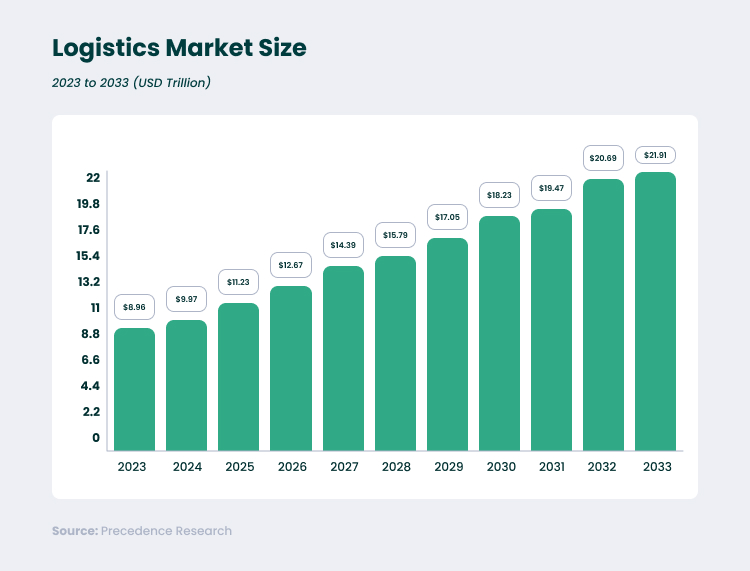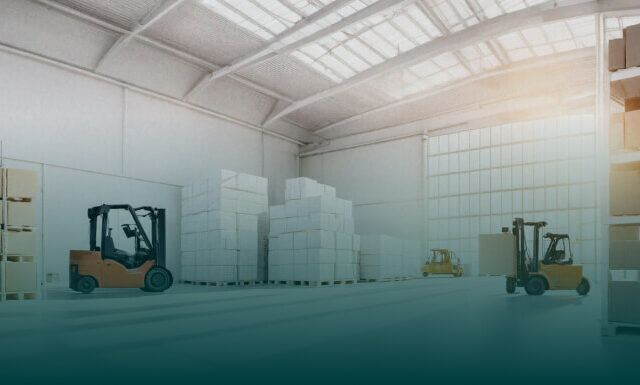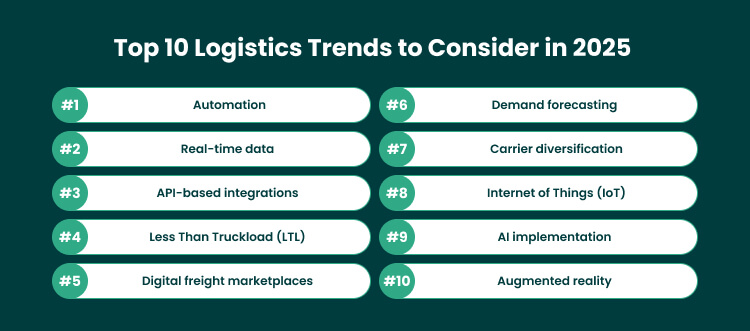The logistics industry is at a turning point. According to Precedence Research, in 2024, it reached a staggering $9,97 trillion. By 2033, it’s expected to double to $21,91 trillion. That’s exciting, right? But with growth comes challenges.

High transportation costs, supply chain disruptions, and labor shortages are making it harder to keep things running smoothly. Truckload spot rates are set to jump by 6,5-7% in 2025, and 61% of companies feel the strain of transportation delays due to understaffing. On top of that, 37% of businesses report struggling with labor shortages, making efficiency more critical than ever.
The good news? The industry doesn’t stand still. Businesses are adopting new logistics trends that can make their supply chain management more efficient and competitive. From AI-powered analytics to automation, emerging technologies are reshaping logistics into a dynamic and agile area.
In this article, we’ll reveal the top 10 logistics trends that will influence your company in 2025. Whether you’re a startup or an experienced player, these insights will help you streamline operations and future-proof your business. Let’s dive in.
2024 in Logistics: What Changed and Why It Matters
Looking back at 2024, the logistics industry experienced impressive growth. The supply chain sector is home to more than 166,200 companies globally, showing its appeal to startups alike.
Employee numbers surged, with an increase of 796,000 workers last year, bringing the global logistics workforce to 14,5 million. The future of logistics looks bright as the industry continues to grow, attract new talent, and give birth to new logistics trends.
Innovation is also on the rise. Over 31,000 patents were filed in the logistics sector, highlighting key tech advancements. On top of that, there were 32,000 funding rounds, with investors contributing more than $16.5 billion to logistics startups and projects.
These numbers paint a picture of an attractive and evolving industry. But even with all this growth, some challenges could hold back companies from fully integrating into this vertical. We’ll explore them further down.
Hurdles the logistics industry faced in 2024
What challenges held businesses back in 2024? And how did they impact the logistics industry?
First, global events like wildfires, floods, and wars disrupted supply chains. To bounce back, companies turned to ecosystem integration software for smoother operations.
Second, many companies faced problems with trading partners not keeping their promises. To fix this, 29% planned to form new partnerships with more reliable businesses.
Third, staffing shortages were still a big issue. To solve it, 30% of companies invested in automation technology to streamline their operations.
Finally, costs kept rising in 2024. To manage this, companies adopted supply chain tech and ecosystem integration, with 43% expecting cost savings and 33% looking for higher revenue.
These challenges are tough, but with the right logistics trends, companies can keep moving forward.
Top 10 Logistics Trends to Consider in 2025
Sticking to traditional logistics models may still work, but if you’re aiming for growth and progress, staying old-fashioned won’t cut it. That’s why we recommend considering these logistics trends for 2025 to transform your business approach and unlock new opportunities.
Trend 1: Automation for smarter operations
Intelligent automation is a must for logistics companies today. It helps cut costs and frees up your staff to focus on more important tasks. With so many systems and platforms in use, managing all that data can be a challenge. It’s crucial for decision-making, but collecting it from different sources can be time-consuming.
By automating operations, you can streamline your data flow. No more switching between software or collecting data manually. Automation pulls everything together in one place, keeping it organized and up-to-date. Adopt this logistics trend, and let your business work smarter, not harder.
For example, Amazon uses automated sorting systems with conveyor belts and robots to organize packages. This speeds up sorting and helps deliver packages faster and more accurately.
Trend 2: Real-time data for order visibility
Real-time data has changed how customers expect deliveries. Thanks to this logistics trend, shoppers now get constant updates on their orders, and your business can keep them informed throughout the shipping process.
Consider integrating your system with supply chain visibility platforms to offer real-time updates. These platforms track shipments and automatically send updates to customers. So, they always know where their order is and when it will arrive. This helps customers plan better and stay in the loop.
DHL, a global logistics provider, uses advanced tracking systems to send real-time updates to customers. Their tracking technology notifies customers about their order status, location, and delivery time.
Trend 3: API-based integrations for real-time processing
APIs are becoming a game-changer in logistics. Unlike the old batch methods, APIs process data in real-time. So, logistics companies get instant updates on orders and shipments.
Why is this logistics trend important? Customers today expect frequent updates on their orders, and with APIs, you can deliver just that. By sending real-time updates, you keep everyone, customers and partners, on the same page, making everything run more smoothly.
Take Shopify, for example. They use APIs to connect with logistics and shipping partners. This seamless API integration ensures that their order system talks directly with third-party providers. So, customers get accurate, timely updates on their orders and delivery times.
Trend 4: Less Than Truckload (LTL) for more efficient shipping
With the rise of e-commerce and faster shipping demands, businesses often don’t have enough orders to fill an entire truck. That’s where LTL comes in the logistics industry. It allows multiple smaller shipments from different companies to share one carrier, making it more cost-effective and efficient.
For businesses, this means you only pay for the space you use. Small companies especially benefit, as they can ship goods without the cost of filling an entire truck. Plus, this logistics trend is great for the environment. LTL reduces unused space, cutting down on the number of trips and carriers needed, which lowers emissions.
At Forbytes, we build software that can bring together data from different businesses to help set up this kind of logistics system. It’s a smart way to connect companies and make LTL more seamless and efficient.
Trend 5: Digital freight marketplaces for connecting shippers and carriers
Digital freight marketplaces are online platforms where shippers and carriers can easily connect to arrange transportation. These platforms make it simple for shippers to find the right carriers, while carriers get more business opportunities and can negotiate the best price for a shipment.
For shippers, these marketplaces save time and money by letting them compare different carriers’ prices, services, and delivery times all in one place. Carriers also benefit, as they gain access to a bigger customer base and a simpler booking process. It’s a win-win strategy for both sides.
Convoy is a great example, connecting shippers with available carriers to book shipments quickly. This makes logistics smoother and more efficient.
Trend 6: Demand forecasting for a smooth logistics process
Demand forecasting predicts what customers will need in the future, using big data in logistics like sales history, market trends, and even the economy. Logistics companies can plan by understanding these patterns, helping them manage their resources more efficiently.
By forecasting supply chain demand at different stages of the logistics process (pickup, shipping, and delivery), companies can better optimize their operations. And when combined with supply chain agility, they can stay flexible and competitive. This logistics trend helps reduce disruptions by preparing companies for spikes in demand and ensuring that they have enough resources to meet customer needs.
For example, during peak seasons like Black Friday, Amazon’s demand forecasting helps them scale operations efficiently, meeting the surge in customer orders without significant delays.
Trend 7: Carrier diversification for better service
More e-commerce brands are moving away from big carriers like FedEx and UPS. Why? They want lower costs, fewer surcharges, and better service. Regional carriers offer competitive pricing and reliable shipping. That’s why this is an attractive option.
With advanced technology like transportation management systems (TMS), businesses can seamlessly connect with multiple regional carriers.
By developing TMS solutions, we help businesses diversify their carrier options, reduce costs, and improve delivery efficiency. As this logistics trend grows, shippers gain more control and flexibility in their logistics operations.
Trend 8: IoT for supply chain visibility
IoT (Internet of Things) is making logistics smarter by enabling real-time tracking of shipments, vehicles, and warehouses. With sensors and RFID tags, businesses can monitor goods instantly, reducing delays and other issues.
Why does this logistics trend matter? IoT helps companies manage inventory better, predict maintenance needs, and improve security. It connects every part of the supply chain, ensuring smooth operations.
A game-changer in this space is smart labels, now evolving into “Smart Printables.” These advanced labels will provide even more real-time data, making tracking faster and more accurate worldwide.
Trend 9: AI implementation for supply chain optimization
AI remains a key logistics trend that makes supply chains smarter and more efficient. AI can analyze data, learn from past trends, and predict future needs. This means better route planning, smarter inventory management, and improved asset tracking. Generative AI tools help businesses optimize stock levels and streamline operations.
One exciting development is computer vision, which uses AI in logistics to track and manage inventory with incredible accuracy. Experts believe it will soon become a standard in logistics, making supply chains faster and more reliable. Companies that adopt AI will stay ahead with smarter, more efficient operations.
Trend 10: Augmented reality for a smoother workflow
Augmented reality (AR) is changing the supply chain by making operations faster, smarter, and more efficient. With AR-powered smart glasses and devices, workers get real-time data, reducing mistakes and boosting productivity. This logistics trend also improves security by tracking shipments, leading to happier customers.
For example, DHL is using AR in warehouses with its Vision Picking system. Employees wear smart glasses that show them digital picking lists and the best routes to find items.
Want to stay ahead with the latest logistics trends? Get in touch with our team, we’ll help you boost efficiency, improve performance, and grow your revenue!
The Future of Logistics: What Will the Industry Look Like in 5 Years?
What will the logistics industry look like in 5 to 10 years? It’s a big question, but let’s explore some possibilities.
One scenario is more collaboration. Big players might stay on top with ‘Physical Internet’ (PI) solutions. Think of standardized shipment sizes, labels, and systems that make everything run smoother and faster.
Another possibility? Startups could shake up delivery, especially with last-mile challenges. These newcomers might use tech like crowd-sharing to create a more flexible delivery system, often partnering with larger companies.
Then there’s the chance that big companies in retail or industry won’t just handle their logistics, they might turn it into a business. As a result, this will ensure a new level of competition.
Lastly, the big players today might grow even bigger by acquiring smaller companies. It’s all about scale, innovation, and staying ahead of the supply chain game.
These future logistics trends will shape the landscape. By keeping an eye on them, you can plan and adapt to stay successful in a dynamic world. What do you think? Are you ready for the future of logistics?
How Forbytes Can Help You Keep Up with Logistics Industry Trends
The logistics trends we’re sharing here come from industry leaders. So, if you’re looking to fuel your business with the latest tech, you can follow their example and add your unique touch to create a brilliant solution your customers will love.
Looking for a professional team to help you stay on top of the latest logistics trends? Look no further! At Forbytes, we’re here to help you keep up with the fast-changing logistics world and optimize your supply chain. Whether it’s using AI or connecting systems with APIs, we’ve got your back.
Ready to take your logistics to the next level? Contact us today to discover how Forbytes can help you thrive in this dynamic industry.











